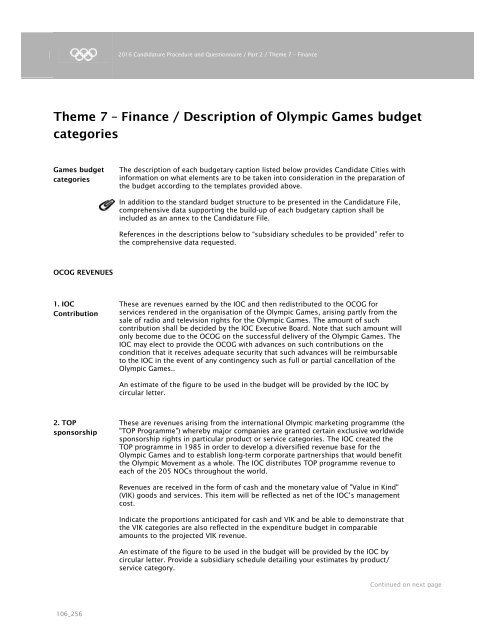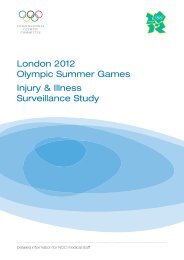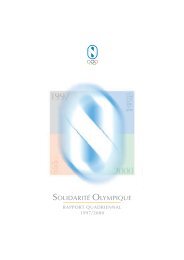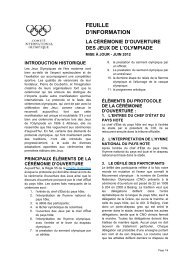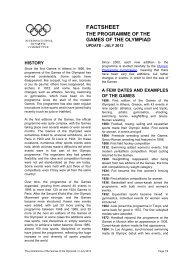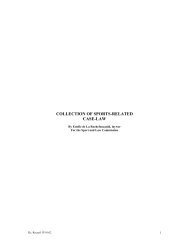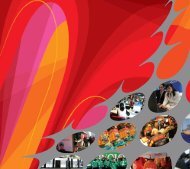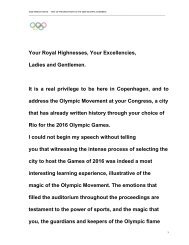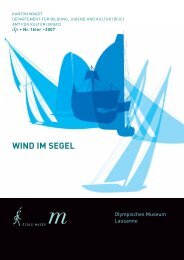2016 CANDIDATURE PROCEDURE AND QUESTIONNAIRE
2016 CANDIDATURE PROCEDURE AND QUESTIONNAIRE
2016 CANDIDATURE PROCEDURE AND QUESTIONNAIRE
Create successful ePaper yourself
Turn your PDF publications into a flip-book with our unique Google optimized e-Paper software.
106_256<br />
<strong>2016</strong> Candidature Procedure and Questionnaire / Part 2 / Theme 7 – Finance<br />
Theme 7 – Finance / Description of Olympic Games budget<br />
categories<br />
Games budget<br />
categories<br />
OCOG REVENUES<br />
1. IOC<br />
Contribution<br />
2. TOP<br />
sponsorship<br />
The description of each budgetary caption listed below provides Candidate Cities with<br />
information on what elements are to be taken into consideration in the preparation of<br />
the budget according to the templates provided above.<br />
In addition to the standard budget structure to be presented in the Candidature File,<br />
comprehensive data supporting the build-up of each budgetary caption shall be<br />
included as an annex to the Candidature File.<br />
References in the descriptions below to “subsidiary schedules to be provided” refer to<br />
the comprehensive data requested.<br />
These are revenues earned by the IOC and then redistributed to the OCOG for<br />
services rendered in the organisation of the Olympic Games, arising partly from the<br />
sale of radio and television rights for the Olympic Games. The amount of such<br />
contribution shall be decided by the IOC Executive Board. Note that such amount will<br />
only become due to the OCOG on the successful delivery of the Olympic Games. The<br />
IOC may elect to provide the OCOG with advances on such contributions on the<br />
condition that it receives adequate security that such advances will be reimbursable<br />
to the IOC in the event of any contingency such as full or partial cancellation of the<br />
Olympic Games..<br />
An estimate of the figure to be used in the budget will be provided by the IOC by<br />
circular letter.<br />
These are revenues arising from the international Olympic marketing programme (the<br />
"TOP Programme") whereby major companies are granted certain exclusive worldwide<br />
sponsorship rights in particular product or service categories. The IOC created the<br />
TOP programme in 1985 in order to develop a diversified revenue base for the<br />
Olympic Games and to establish long-term corporate partnerships that would benefit<br />
the Olympic Movement as a whole. The IOC distributes TOP programme revenue to<br />
each of the 205 NOCs throughout the world.<br />
Revenues are received in the form of cash and the monetary value of "Value in Kind"<br />
(VIK) goods and services. This item will be reflected as net of the IOC’s management<br />
cost.<br />
Indicate the proportions anticipated for cash and VIK and be able to demonstrate that<br />
the VIK categories are also reflected in the expenditure budget in comparable<br />
amounts to the projected VIK revenue.<br />
An estimate of the figure to be used in the budget will be provided by the IOC by<br />
circular letter. Provide a subsidiary schedule detailing your estimates by product/<br />
service category.<br />
Continued on next page


